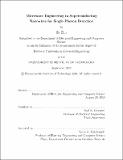| dc.contributor.advisor | Karl K. Berggren. | en_US |
| dc.contributor.author | Zhu, Di,Ph. D.Massachusetts Institute of Technology. | en_US |
| dc.contributor.other | Massachusetts Institute of Technology. Department of Electrical Engineering and Computer Science. | en_US |
| dc.date.accessioned | 2020-03-09T18:59:00Z | |
| dc.date.available | 2020-03-09T18:59:00Z | |
| dc.date.copyright | 2019 | en_US |
| dc.date.issued | 2019 | en_US |
| dc.identifier.uri | https://hdl.handle.net/1721.1/124123 | |
| dc.description | This electronic version was submitted by the student author. The certified thesis is available in the Institute Archives and Special Collections. | en_US |
| dc.description | Thesis: Ph. D., Massachusetts Institute of Technology, Department of Electrical Engineering and Computer Science, 2019 | en_US |
| dc.description | Cataloged from student-submitted PDF version of thesis. | en_US |
| dc.description | Includes bibliographical references (pages 149-163). | en_US |
| dc.description.abstract | Detecting light at the single-photon level plays a crucial role in photonic quantum information processing, deep-space optical communication, astronomical observation, and biological and chemical sensing. With their exceptional performance, superconducting nanowire single-photon detectors (SNSPDs) have emerged as the leading single-photon counting technology at infrared wavelengths. Conventionally, the superconducting nanowires are treated as lumped circuit elements, and their microwave properties were largely neglected. In this thesis, we engineer the nanowires into kinetic-inductive transmission lines and use them to devise new single-photon detector architectures. Through impedance engineering, we developed a superconducting tapered nanowire detector that has increased output voltage, reduced timing jitter, and most importantly, the ability to resolve photon numbers. Utilizing the slow propagation speed of electrical signals in the nanowire transmission lines, we developed a delay-line-multiplexed detector array. This two-terminal array can perform coincidence counting over a large number of spatial modes and can be scalably integrated on photonic waveguides. | en_US |
| dc.description.statementofresponsibility | by Di Zhu. | en_US |
| dc.format.extent | 163 pages | en_US |
| dc.language.iso | eng | en_US |
| dc.publisher | Massachusetts Institute of Technology | en_US |
| dc.rights | MIT theses are protected by copyright. They may be viewed, downloaded, or printed from this source but further reproduction or distribution in any format is prohibited without written permission. | en_US |
| dc.rights.uri | http://dspace.mit.edu/handle/1721.1/7582 | en_US |
| dc.subject | Electrical Engineering and Computer Science. | en_US |
| dc.title | Microwave engineering in superconducting nanowires for single-photon detection | en_US |
| dc.type | Thesis | en_US |
| dc.description.degree | Ph. D. | en_US |
| dc.contributor.department | Massachusetts Institute of Technology. Department of Electrical Engineering and Computer Science | en_US |
| dc.identifier.oclc | 1142634562 | en_US |
| dc.description.collection | Ph.D. Massachusetts Institute of Technology, Department of Electrical Engineering and Computer Science | en_US |
| dspace.imported | 2020-03-09T18:58:59Z | en_US |
| mit.thesis.degree | Doctoral | en_US |
| mit.thesis.department | EECS | en_US |
